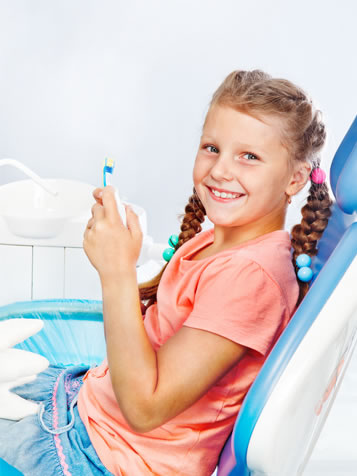Dental Exams and Cleanings
Preventing Problems Before They Start
The health of your child’s teeth and mouth is very important to the well-being of his or her entire body, and while routine brushing and flossing at home is necessary to keep your child’s smile looking its best, visiting the dentist for a comprehensive exam and cleaning is essential. The American Dental Association recommends that your child visit the dentist every six months to ensure his or her teeth stay healthy and smile stays beautiful.
By routinely seeing the dentist for exams and cleanings, your child can:
- Prevent tooth decay, gum disease, and bad breath
- Avoid costly and extensive dental procedures
- Have white teeth by reducing staining from food and drinks
- Shorten the time spent in the dentist’s office
- Have a smile that will last a lifetime
The Exam
During your child’s exam, the dentist will thoroughly examine your child’s teeth and gums for signs of tooth decay, gum disease, and other health problems. The dentist may also want to take X-rays to see what is happening beneath the surface of the teeth and gums. Whether these X-rays are traditional or digital, the images provided will help the dentist discover dental issues not visible to the naked eye.
Professional Cleanings
The dental hygienist will begin your child’s cleaning by exploring the surface of the teeth to determine if there are any cavities and to examine the quality of existing fillings. The dental hygienist will then perform a periodontal exam to make sure your child’s gums adhere tightly to the teeth, and no periodontal disease or bone loss is present.
Next, the hygienist will carefully clean your child’s teeth with a variety of tools to remove any hard mineral buildup (tartar) from the teeth. Then, the hygienist will floss your child’s teeth, use a polishing compound, and apply fluoride. Cleanings usually aren’t painful, but if your child has any anxiety about the dental exam, be sure to let the hygienist know. They may offer several sedation options to ensure your child’s comfort. If the dentist or hygienist finds tooth decay or gum disease, they will talk to you about changing your child’s brushing or flossing habits. In severe cases, they may recommend antibiotics or other dental treatments. If your child’s teeth and gums appear to be healthy, the dentist will probably recommend that your child continue his or her brushing and flossing routine as usual.

